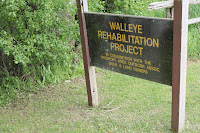 |
| Fishing Guy –He's a happy man! |
 We've often gone to Westport for fun, frolic, Blues music, or sometimes just to sit by the water.
We've often gone to Westport for fun, frolic, Blues music, or sometimes just to sit by the water.I've noticed the project sign and I became curious enough to do some research.
One of the issues with building roads over bodies of water, is creating a causeway but keeping the integrity of a bay, where fish spawn, visit, and blue heron find their food. This dam is protecting the Walleye (Stizostedion vitreum vitreum) who use the Westport Bay for spawning.
 |
| Excellent fried –good to take the photo whilst not drooling! |
Many groups, including Ducks Unlimited, as well as fishers groups, aim to balance and maintain the population in a healthy ecosystem. We can do much to protect our critters, as well as harvesting them for our own use. This is something we have done, as a species, since time memorial.
 For those to whom much is given (i.e., a
For those to whom much is given (i.e., a cottage on a lake shore) much is required. Species, such as walleye, can be terribly impacted by those who build cottages and destroy shorelines. Fast boats are the bane of existence to good fish habitat. Many creatures require shorelines.
My friend, Fishing Guy, has been fishing for 60 years. He often travels about this continent. I asked if he had a photo of Walleye I might use. We don't fish!
 |
| My blog buddy, Fishing Guy, shared his photos! |
He tells me:
Most of the time I use bobbers. I use night crawlers and jigs with curly tails body. I troll and use Hot-N-Tots which is a minnow shaped lure. This year I have caught quite a few fish on a lure called a Vibe. You jig them off the bottom. My favorite color on my artificial lures is chartreuse.According to Wiki: In some parts of its range, the walleye is known as the colored pike, yellow pike or pickerel (especially in English-speaking Canada), although the fish is not related to other species of pikes which are members of the family Esocidae.
Fishing Guy writes:
 |
| Westport is popular for fishing |
15" to 17" range with a few over 18". They grow about half as fast as they do in Ohio, about 3" a year. There were a lot of fish available and you could catch a limit quickly. We still had a fish fry most every night and the boys loved it.
 |
| Interesting lure! |
 |
| Westport Bay on the right, to the left Upper Rideau Lake, with the road going into Westport. |
 |
| The orange booms keep people away -supposedly. |
Habitat Requirements
The MNR publishes information (Walleye Habitat: A Synthesis of Current Knowledge withGuidelines for Conservation –PDF) about:
Space, Water, Flow, Cover, Food.
There appear to be three basic factors which limit the natural range of walleye: height of land which physically separates different watersheds, salinity, and high summer temperatures (Collette et al. 1977).
The depth of water, and the temperature the fish requires for spawning (~20 C.), are important factors. Water depth is important; they prefer a depth of 3 - 10m. They require a certain amount of oxygen for the eggs and hatchlings, pH levels (>5.1), a specific spring temperature (5 - 10 C.), and water velocity for spawning and fertilizing eggs. "Flows at a spawning site in Upper Rideau Lake, Ontario, usually range from 1.01-1.10 m sec-1 (Environmental Applications Group Ltd. 1980)."
 |
| Habitat for walleye |
It's amazing what research will tell us about a species!
Prevalence in Ontario
Carlander et al. (1978) estimated that walleye inhabit approximately 32% of the total freshwater area of North America. In Ontario, however, walleye are found in 90.6% of the available freshwater habitat (excluding the Great Lakes). Walleye are present in all of the Great Lakes and at least 4038 inland lakes. The majority of these waters (3621 lakes) are situated in northern Ontario (north and west of the French River, see Fig. 1).Food Sources
Yellow perch (Perca flavescens), alewife (Alosa pseudoharengus), rainbow smelt (Osmerus mordax), and suckers (Catostomus spp.) are the most common prey items. |
| A spring view of the vista! On the left, Big Rideau Lake, on the right, Westport Bay. |
Habitat preserve
On the bay side, there is a ramp leading up to the outflow. This is what the orange buoys protect. The water is relatively low, right now. |
| This is a delightful spot, leading into Big Rideau Lake. |
 |
| Lots of sunfish are visiting this spot |
 |
| It has a calming effect on the soul. |





4 comments:
Walleye and pickerel are the same fish?! Who knew!!! Thanks for all the facts. I learned a l ot.
I stopped fishing when I was in my teens, foun dit so boreing. It's not something I could take back up even now.
Jenn: Wonderful post with a lot of great information. Canada has some great Walleye fishing. It can be boring when no fish are caught but so rewarding when you bring in great tasting fish.
Great post, here. I LOVE walleye.. one of the nicest eating fish and we're lucky to have them populate the lake to which we've moved. Hard to find them though. I am pretty new to fishing (about 5 years) and never find it boring. Of course I only go out on nice days and I always have my camera along. Catching one is always a kick but it's lovely just being there.
Post a Comment